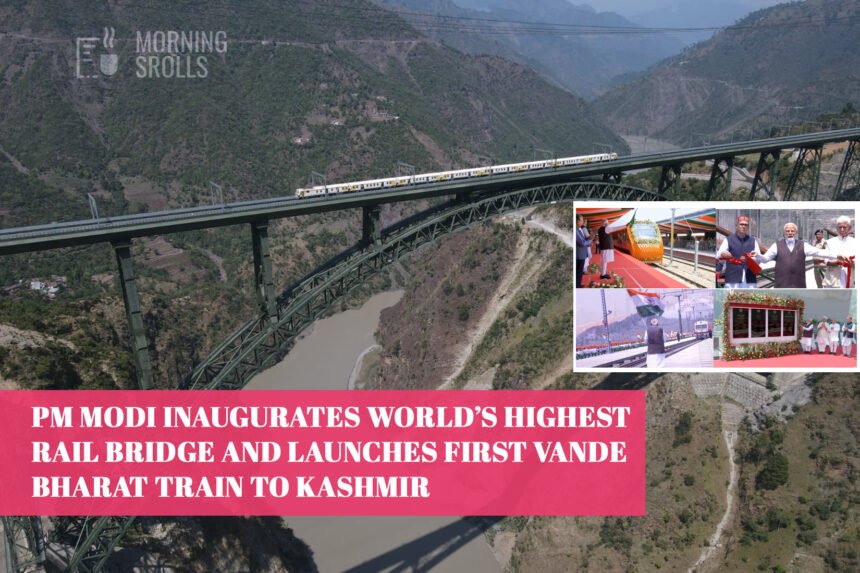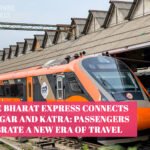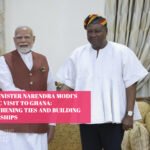On Friday, Prime Minister Narendra Modi marked a historic moment for India by inaugurating the Chenab rail bridge, which is now the world’s tallest railway arch bridge. This event also celebrated the completion of a project that has been in the making for 42 years—finally connecting the Kashmir Valley to the rest of India by train.
For decades, the dream of linking Kashmir with the Indian railway network has faced significant challenges due to the region’s rugged mountainous terrain and harsh weather conditions. With the completion of the Udhampur-Srinagar-Baramulla Rail Line (USBRL), this dream is now a reality. Spanning 272 kilometers across the Himalayan mountains, the USBRL is one of India’s most difficult and remarkable railway projects ever built.
The Chenab Rail Bridge: An Engineering Marvel
One of the most striking features of this railway line is the Chenab rail bridge, the tallest railway arch bridge in the world. Built over the Chenab River in Jammu and Kashmir, it rises 359 meters above the river, making it even taller than the Eiffel Tower. The bridge is not just a feat of engineering but also a symbol of India’s determination to connect even the most remote regions.
A Journey Through Time: The USBRL Project
The USBRL project was launched over four decades ago, but progress was slow due to the region’s difficult geography and security concerns. Over the years, the railway line was completed in several phases:
- Qazigund to Baramulla (118 km): Opened in October 2009, this section brought train service to the northern part of the valley.
- Qazigund to Banihal (18 km): Completed in June 2013, this stretch included the Pir Panjal tunnel, one of the longest railway tunnels in India.
- Udhampur to Katra (25 km): Opened in July 2014, this section allowed pilgrims easier access to the famous Vaishno Devi shrine.
The newest part of the railway, stretching 48.1 kilometers from Banihal to Sangaldan, was finished in February 2024. This new stretch brings the railway line closer to connecting the Kashmir Valley fully. With the final stretch now complete, the entire 272-kilometer line is fully electrified and operational, connecting Udhampur in Jammu to Baramulla in Kashmir.

A Network of Tunnels and Bridges
Building a railway through the Himalayas is no easy task. The USBRL project features 36 tunnels that together cover 119 kilometers, along with 943 bridges built to span rivers, valleys, and hilly terrain. These tunnels and bridges were necessary to overcome the region’s rugged landscape and ensure safe, reliable train travel.
Vande Bharat Express: Bringing Modern Rail to the Valley
During the bridge inauguration, Prime Minister Modi also launched the first Vande Bharat Express train connecting Katra in Jammu with Srinagar in Kashmir. This is the first time a modern, high-speed train will directly link the two regions, making travel faster and more comfortable for locals and tourists alike.
The newly launched Vande Bharat trains are built to handle the harsh winter conditions of the Himalayan region. They can operate smoothly even when temperatures drop to minus 20 degrees Celsius. These trains come with special features such as heated front windows, modern heating setups, and well-insulated toilets, making sure passengers stay warm and the train works smoothly throughout the year.
Who Was Present at the Inauguration?
Several important leaders attended the launch event, such as Railway Minister Ashwini Vaishnaw, Jammu and Kashmir’s Lieutenant Governor Manoj Sinha, and former. The Chief Minister their presence highlighted the significance of this achievement for the region and the country.
Benefits for Jammu and Kashmir
Finishing the USBRL project and starting the Vande Bharat Express service are likely to bring several positive changes to Jammu and Kashmir:
- Better Connectivity: For the first time, people in the Kashmir Valley can travel by train to other parts of India without having to rely on road or air travel.
- Boost to Tourism: Easier access is likely to attract more tourists to the region, which is famous for its natural beauty and cultural heritage.
- Economic Growth: Improved transportation will help local businesses by making it easier to move goods and people. This could lead to new job opportunities and greater prosperity.
- Social Integration: The railway will help bring people from different parts of India closer together, fostering a sense of unity and national integration.
A Costly but Worthwhile Investment
The USBRL project was built at a cost of ₹43,780 crore. While this is a significant investment, the long-term benefits in terms of economic growth, improved connectivity, and national integration are expected to far outweigh the costs.
A Symbol of Progress and Unity
The Chenab rail bridge and the USBRL are more than just infrastructure projects—they are symbols of India’s progress and its commitment to connecting every corner of the country. The bridge, in particular, stands as a testament to what can be achieved with determination, innovation, and teamwork.
With the railway line now complete, attention will turn to maximizing its impact. The government is expected to introduce more train services, improve station facilities, and encourage tourism and trade in the region. The success of the USBRL could also inspire similar projects in other challenging parts of India.
The inauguration of the Chenab rail bridge and the launch of the Vande Bharat Express to Kashmir mark a new chapter in India’s history. After more than four decades of planning and construction, the dream of connecting Kashmir to the rest of the country by train has finally come true. This achievement will not only make travel easier and safer for millions but also open up new opportunities for growth and development in Jammu and Kashmir.
As Prime Minister Modi said during the inauguration, these projects are about more than just trains and bridges—they are about connecting lives, boosting livelihoods, and building a stronger, more united India.










